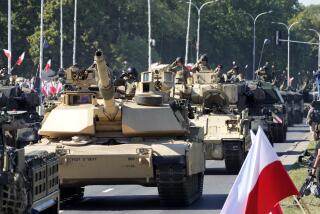Clinton 2nd Term Resembles Ike Redux
- Share via
WASHINGTON — We are beginning to see a new historical precedent that can be applied to President Clinton.
He arrived in the White House modeling himself on the style and youthful dynamism of President John F. Kennedy. In office, Clinton has invited comparisons with Richard Nixon--a chief executive with undeniable political gifts who proved willing to play loose with the rules in his eagerness for reelection.
But when it comes to running the country, the second Clinton term is starting to look most of all like the Dwight D. Eisenhower administration. As in the 1950s, America seems to have a detached president in charge of a relatively prosperous, self-satisfied country. Neither the White House nor the nation seems interested in making any drastic changes in the status quo.
The latest example of our national inertia was the release on Monday of the Quadrennial Defense Review, the Pentagon document that charts the future of the armed forces.
One might be forgiven for thinking that the only issue at the Pentagon these days is sex in the military. Yet this strategic review is of extraordinary significance. It lays out how much money the nation will spend in the next few years and where it will go. It decides what weapons systems will be bought and how many men and women each of the armed services will have.
The answer, according to the review, is that there will be no far-reaching alterations in America’s military structure. In the interests of modernization, the Pentagon proposes to make some minor changes, reducing slightly the number of troops and closing more military bases.
No weapons systems, however, will be abandoned. The Pentagon will still seek to be prepared to conduct two major regional wars at once. Most important, the defense budget will hold for the next few years at about $250 billion annually.
“It’s the status quo,” says Lawrence J. Korb, a former Pentagon official and specialist on the defense budget.
In effect, the Pentagon proposes to save some money by closing bases and reducing troops and use these savings to buy or develop more high-technology weaponry.
The mystery that the defense review doesn’t answer is why America needs to spend on its military a sum vastly greater than that of any possible combination of opponents. Who is the possible enemy?
The report talks about the possibility that North Korea, Iraq or Iran may threaten their neighbors and U.S. interests. But none of these supposed threats seems sufficient to justify such a large defense budget.
The report acknowledges that at least until the year 2015, no other country will be able to pose a military challenge to the United States. After that, the Pentagon says, it is at least conceivable that a “peer competitor” may emerge; the document identifies Russia or China as eventually having the potential to play this role.
Of course, the Pentagon argues that it has already cut back. In order to make its case, it uses as a baseline the year 1985, at the very peak of the Ronald Reagan administration’s Cold War defense buildup. In that year, the Pentagon notes, the nation spent $400 billion (in current dollars) on defense. But that’s a pretty odd standard of comparison.
It seems unfair to blame the Pentagon alone for its unwillingness to foster more significant change. Rather, much of the fault lies at the White House for failing to take on the question of how large a portion of our national resources and budget need to go to the military.
There is a revealing passage in “Locked in the Cabinet”, the new diary by former Labor Secretary Robert B. Reich. He describes what happened during discussions late in 1993 as the Clinton administration drew up the first annual budget of its own.
“Everyone in the room knows that the Defense Department will get what it wants. [Clinton] won’t stand in the way of the Pentagon,” Reich wrote. “Hell, Republicans [and even a few Democrats] are clamoring for even higher defense spending next year, and they’re ready at a moment’s notice to call [Clinton] a coward for eluding the draft.”
You can’t blame the inertia solely on Clinton. Years from now, we may look back on the current period and wish we had devoted more resources to education, our cities and the nation’s infrastructure. But at the moment, the American people seem content with the way things are.
Maybe Clinton will some day take on the questions of whether we are spending too much money on the military, or whether the Pentagon and defense industries have too great a role in American life. One can imagine him doing this just as he is leaving the White House.
There would be precedent for such a warning. Eisenhower did it, too, in his farewell address.
Jim Mann’s column appears in this space every other Wednesday.
Defense Dollar Differences
Some critics question why the Pentagon has proposed a status quo approach to the defense budget, given that U.S. military spending vastly outstrips expenditures by other countries, including such potentially aggressive nations as North Korea, Iraq and Iran. Here is a look at defense spending by country in 1995:
*--*
Country Budget % of Gross Domestic Product 1. U.S. $278 billion 3.8% 2. Russia $82 billion 7.4% 3. Japan $50 billion 1.1% 4. France $48 billion 3.1% 5. Germany $42 billion 2.0% 6. United Kingdom $34 billion 3.1% 7. China $32 billion 5.7% 8. Italy $20 billion 1.8% 9. South Korea $14 billion 3.4% 10. Saudi Arabia $13 billion 10.6% 21. North Korea $5 billion 25.2% 37. Iraq $2.7 billion 14.8% 40. Iran $2.5 billion 3.9%
*--*
SOURCE: International Institute for Strategic Studies
More to Read
Get the L.A. Times Politics newsletter
Deeply reported insights into legislation, politics and policy from Sacramento, Washington and beyond. In your inbox twice per week.
You may occasionally receive promotional content from the Los Angeles Times.










